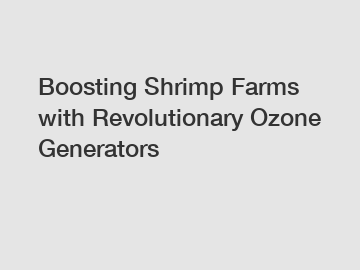Boosting Shrimp Farms with Revolutionary Ozone Generators
Google Hot Topic: Boosting Shrimp Farms with Revolutionary Ozone Generators?
Can ozone generators revolutionize the shrimp farming industry?
Point 1: The challenges faced by shrimp farmers in maintaining water quality.

Shrimp farming is a complex process that requires meticulous attention to water quality. Suboptimal water conditions can lead to diseases, low reproduction rates, and even death of the shrimp. Farmers often struggle to maintain ideal water parameters, such as oxygen levels, ammonia, and nitrite concentrations. Traditional methods of water treatment, such as chemicals or mechanical filtration, are costly and time-consuming.
Point 2: The emergence of ozone generators as a game-changer in shrimp farming.
Enter ozone generators, a revolutionary technology that has the potential to transform the shrimp farming industry. Ozone (O3) is a powerful oxidant that can effectively kill bacteria, viruses, and other pathogens, making it an ideal solution for water treatment. By introducing ozone into shrimp farm water systems, farmers can ensure a healthier environment for their shrimp, promoting growth and reducing disease outbreaks.
Point 3: The benefits of using ozone generators in shrimp farms.
One of the primary advantages of ozone generators is their ability to eliminate harmful microorganisms present in shrimp farm water. Ozone effectively destroys pathogens, such as Vibrio bacteria, which are notorious for causing diseases in shrimp. By eliminating these pathogens, farmers can reduce the need for antibiotics and other chemical treatments, creating a more sustainable and environmentally-friendly shrimp farming process.
Another benefit of ozone generators is their ability to remove organic matter from water. Shrimp produce waste and uneaten feed, leading to an accumulation of organic compounds that can quickly degrade water quality. Ozone oxidizes these organic compounds, breaking them down into harmless byproducts. This process not only improves water clarity but also eliminates foul odors, creating a more pleasant working environment for farmers.
Point 4: The challenges and considerations of implementing ozone generators in shrimp farms.
While ozone generators offer numerous advantages, their implementation also presents certain challenges. Ozone can be toxic to living organisms, including shrimp, if not used properly. It is crucial for farmers to monitor ozone levels carefully to prevent any adverse effects on shrimp health. Additionally, the technology requires appropriate infrastructure and expertise for effective operation.
To overcome these challenges, farmers must ensure proper ozone dosing and integration into their water systems. They should consider factors such as water flow rates, ozone concentration adjustments, and the use of ozone diffusion systems to optimize ozone distribution. Regular water quality monitoring is also necessary to ensure that the ozone treatment is maintaining the desired water parameters.
Conclusion:
Ozone generators have the potential to revolutionize the shrimp farming industry by addressing fundamental challenges in maintaining water quality. By effectively eliminating pathogens and organic matter, these generators can create a healthier and more sustainable environment for shrimp. However, careful implementation and monitoring are vital to ensure the optimal use of ozone technology without adverse effects on shrimp health. As shrimp farming continues to evolve, utilizing revolutionary tools like ozone generators can lead to improved productivity and profitability in this growing industry.
For more information, please visit 10kg Ozone Generator, 5kg ozone generator , 5kg Ozone Generator.


